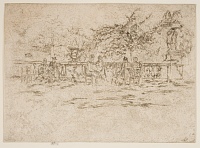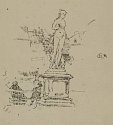Etchings Institutions search term: grolier club
The Little Terrace, Luxembourg Gardens, No. 2 | ||
| Number: | 444 | |
| Date: | 1889/1890 | |
| Medium: | etching | |
| Size: | 128 x 178 mm | |
| Signed: | butterfly at upper left | |
| Inscribed: | no | |
| Set/Publication: | no | |
| No. of States: | 1 | |
| Known impressions: | 2 | |
| Catalogues: | K.426; M.423 | |
| Impressions taken from this plate (2) | ||
KEYWORD
TITLE
'The Little Terrace, Luxembourg Gardens, No. 2' (1903/1935, possibly Rosalind Birnie Philip (1873-1958)). 2
'The Terrace, Luxembourg Gardens' (1904, Grolier Club). 3
'Luxembourg Gardens' (1905, ISSPG). 4
'Terrace, Luxembourg Gardens. No. 3' (1909, Howard Mansfield (1849-1938)). 5
'Terrace, Luxembourg Gardens, No. 2' (1910, Edward Guthrie Kennedy (1849-1932)). 6
'The Little Terrace, Luxembourg Gardens, No. 2' is the preferred title, based on a title that may have originated with Whistler, and which was recorded on the envelope containing the copper plate. The first of the two related subjects is Little Terrace, Luxembourg Gardens [443]. It would seem that Mansfield and Kennedy disagreed about which came first, and in fact there is simply no way of knowing.
2: Envelope containing copper plate, University of Glasgow.
3: New York 1904a (cat. no. 352).
4: London Mem. 1905 (cat. no. 377).
5: Mansfield 1909 (cat. no. 423).
6: Kennedy 1910 (cat. no. 426).
DESCRIPTION
SITE
7: Sénat official website at http://www.senat.fr / visite/jardin/statues.html (accessed 2011).

